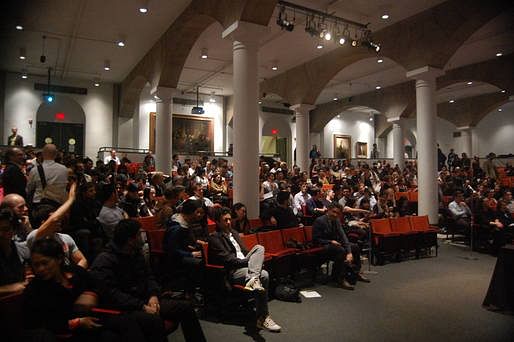
This past Tuesday, The Architectural League of New York hosted a lecture at Cooper Union by architect Sou Fujimoto, entitled “Between Nature and Architecture”. Despite the great number of practitioners and students in attendance (almost a full-house), the event felt more like an intimate conversation with the architect, as he shared his unique brand of architectural investigation. Each project he presented helped substantiate his lifelong interest in blurring the boundaries of established architectural conceptions. Fujimoto explained that he is inspired by dissolving such falsely dichotomous themes as: nature and architecture, the house and the city, complexity and simplicity, or inside and outside, in order to examine the new possibilities that exist “in between.”

The lecture progressed rather linearly, tracing his practice's themes from their conceptual foundation in his “younger ideas” through to their mature forms. As he talked us through some of his earliest conceptual sketches, they began to clearly resemble the ideas that would later become driving forces for some of his most seminal works. For example, an early conceptual sketch of maze-like nested boxes raises the same questions of boundaries and permeability as his realized residential project, House N. In both, Fujimoto uses layers of perforated shells to create a gradient of enclosure, rather than a normal, solid external wall, complicating the boundary between the street and the house, the inside from the outside.
As he showed both, he raised the question, "Where does the house begin?" House N's outermost wall covers the entire site, creating a semi-indoor garden, and as the user moves further into the house, entering the other two layers of nested boxes, the house provides an array of conditions, varying from public to private, open to closed, exposed to protected. A similar number of experiential options exist in Fujimoto's House NA. Clad in glass with optional layers of curtains, the house allows the inhabitants to play with the idea of privacy and choose the degree to which their house is separated from its context. This theme of "choice" is prevalent throughout all of the works Fujimoto presented. He aptly described his work as “democratic”. The “in between” leads to “a richness of experience” that allows each user a unique, individual freedom to inhabit his architecture as they like.

This playful, spontaneous attitude toward architecture is best exemplified in Fujimoto’s Serpentine Gallery Pavilion 2013 in London, which took up a large portion of the lecture. Fujimoto proclaimed this work as the “crystallization” of his thematic investigations. Constructed out of 20mm thin steel pipes, the Pavilion is, at close-range, a uniform 3D grid that can be described as “artificial” or “ordered”. Yet from afar, this uniformity gives way to a beautifully chaotic landscape of possibilities. Hard, linear pipes create a soft, organic form that users can climb, sit on, sleep on, or simply sit beneath and experience being “in between” countless dualities –artificial and organic, opaque and transparent, furniture and architecture, landscape and structure. What’s more, this complex experiential form was achieved through rather traditional means. Fujimoto explained that the Serpentine Pavilion could not be conceived within the computer, but had to be physically modeled and explored at 1:10 scale, before being translated into the computer. In a field so obsessed with advancements in technology, Fujimoto’s work stands out as refreshingly ingenious for innovating new typologies out of existing means.

This knack for finding something new “in between” old or established concepts is what makes Fujimoto’s work so compelling. In his hands, a simple box can give way to a structure of endless complexity. Where others in the field battle to invent new forms through high-tech means, Fujimoto seems to casually play with and explore the obvious with an almost childlike (but not naïve) imagination. In Fujimoto’s world, it is not thinking outside of the box, but rather between the boxes, that creates new ideas in architecture.
The Architectural League of New York continues their lecture series on April 24th with “The Five Thousand Pound Life: Prosperity for a Finite Planet” by author Tim Jackson, at the Scholastic Auditorium. More information can be found here.
No Comments
Block this user
Are you sure you want to block this user and hide all related comments throughout the site?
Archinect
This is your first comment on Archinect. Your comment will be visible once approved.